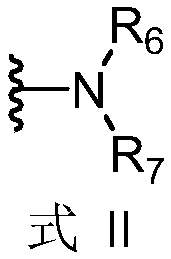Organic metal complex and organic light-emitting device thereof
An organometallic and complex technology, applied in indium organic compounds, platinum group organic compounds, electric solid devices, etc., can solve problems such as the inability to provide satisfactory luminescence characteristics, and achieve improved glass transition temperature and thermal stability, The effect of high luminous brightness and long service life
- Summary
- Abstract
- Description
- Claims
- Application Information
AI Technical Summary
Problems solved by technology
Method used
Image
Examples
Embodiment 1
[0089] Embodiment 1: the preparation of compound TM1
[0090]
[0091]
[0092] Under argon protection, compound C1 (2.36g, 20mmol), compound D1 (9.24g, 44mmol), potassium carbonate (5.5g, 40mmol), bis(tri-tert-butylphosphine) palladium (20.4 g, 0.04mmol), toluene (200ml), stirred under reflux for 5 hours, cooled to room temperature, extracted with toluene, washed with water, dried over anhydrous sodium sulfate, and purified by column chromatography to obtain intermediate A1 (3.1g, 62%) .
[0093] Under the protection of nitrogen, intermediate A1 (3.0g, 12mmol), iridium trichloride trihydrate (1.76g, 5mmol), and purified water (5ml) were successively added to the flask, and refluxed at 150°C for 12 hours to stop the reaction. 150 ml of distilled water was added to precipitate a precipitate, the reaction mixture was filtered, the filter cake was washed with absolute ethanol, and dried to obtain intermediate B1.
[0094] Add compound E1 (62.8mg, 0.4mmol) and n-hexane (10...
Embodiment 2
[0095] Embodiment 2: the preparation of compound TM11
[0096] Compound D1 in Example 1 was replaced by equimolar compound D2, and other steps were the same as in Example 1 to obtain compound TM11 (262 mg, 65%). Mass spectrum m / z: theoretical value: 1011.25; found value: 1013.52. Theoretical element content (%)C 55 h 46 IrN 8 : C, 65.33; H, 4.59; Ir, 19.01; N, 11.08; Measured element content (%): C, 65.31; H, 4.65; Ir, 19.00; N, 11.05. The above results confirmed that the obtained product was the target product.
[0097]
Embodiment 3
[0098] Embodiment 3: the preparation of compound TM16
[0099] Compound D1 in Example 1 was replaced by equimolar compound D3, compound F1 was replaced by equimolar compound F2, and other steps were the same as in Example 1 to obtain compound TM16 (298 mg, 62%). Mass spectrum m / z: theoretical value: 1203.59; found value: 1205.73. Theoretical element content (%)C 69 h 70 IrN 8 : C, 68.86; H, 5.86; Ir, 15.97; N, 9.31; Measured element content (%): C, 68.83; H, 5.92; Ir, 15.95; N, 9.30. The above results confirmed that the obtained product was the target product.
[0100]
PUM
 Login to View More
Login to View More Abstract
Description
Claims
Application Information
 Login to View More
Login to View More - R&D
- Intellectual Property
- Life Sciences
- Materials
- Tech Scout
- Unparalleled Data Quality
- Higher Quality Content
- 60% Fewer Hallucinations
Browse by: Latest US Patents, China's latest patents, Technical Efficacy Thesaurus, Application Domain, Technology Topic, Popular Technical Reports.
© 2025 PatSnap. All rights reserved.Legal|Privacy policy|Modern Slavery Act Transparency Statement|Sitemap|About US| Contact US: help@patsnap.com



